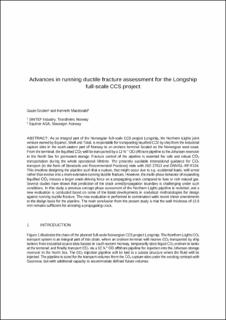| dc.contributor.author | Gruben, Gaute | |
| dc.contributor.author | Macdonald, Kenneth Alasdair | |
| dc.date.accessioned | 2023-03-30T13:16:43Z | |
| dc.date.available | 2023-03-30T13:16:43Z | |
| dc.date.created | 2022-11-30T09:54:59Z | |
| dc.date.issued | 2022 | |
| dc.identifier.citation | Gruben, Gaute; Macdonald, Kenneth Alasdair. Advances in running ductile fracture assessment for the Longship full-scale CCS project. Technology for Future and Ageing Pipelines : TFAP 2022; 2022-03-29 - 2022-03-31 | en_US |
| dc.identifier.uri | https://hdl.handle.net/11250/3061215 | |
| dc.description.abstract | As an integral part of the Norwegian full-scale CCS project Longship, the Northern Lights joint venture owned by Equinor, Shell and Total, is responsible for transporting liquified CO2 by ship from the industrial capture sites in the south-eastern part of Norway to an onshore terminal located on the Norwegian west coast. From the terminal, the liquified CO2 will be transported by a 12 ¾’’ OD offshore pipeline to the Johansen reservoir in the North Sea for permanent storage. Fracture control of the pipeline is essential for safe and robust CO2 transportation during the whole operational lifetime. The presently available international guidance for CO2 transport (in the form of Standards and Recommended Practices) rests with ISO 27913 and DNVGL-RP-F104. This involves designing the pipeline such that a rupture, that might occur due to e.g. accidental loads, will arrest rather than evolve into a more extensive running ductile fracture. However, the multi-phase behavior of expanding liquified CO2 induces a larger crack-driving force on a propagating crack compared to lean or rich natural gas. Several studies have shown that prediction of the crack arrest/propagation boundary is challenging under such conditions. In this study a previous concept-phase assessment of the Northern Lights pipeline is revisited, and a new evaluation is conducted based on some of the latest developments in analytical methodologies for design against running ductile fracture. The new evaluation is performed in combination with recent minor amendments to the design basis for the pipeline. The main conclusion from the present study is that the wall thickness of 15.9 mm remains sufficient for arresting a propagating crack. | en_US |
| dc.language.iso | eng | en_US |
| dc.title | Advances in running ductile fracture assessment for the Longship full-scale CCS project | en_US |
| dc.type | Lecture | en_US |
| dc.description.version | acceptedVersion | en_US |
| dc.rights.holder | The owners/authors | en_US |
| dc.subject.nsi | VDP::Teknologi: 500 | en_US |
| dc.identifier.cristin | 2085095 | |
| dc.relation.project | Norges forskningsråd: 257579/E20 | en_US |
| cristin.ispublished | true | |
| cristin.fulltext | postprint | |
